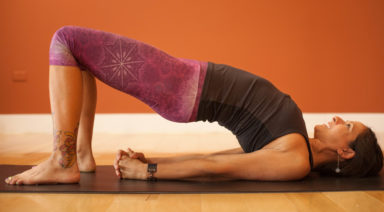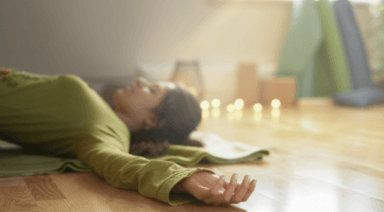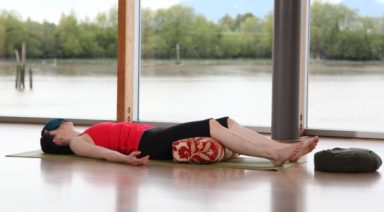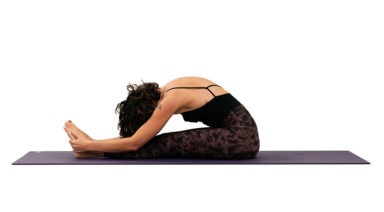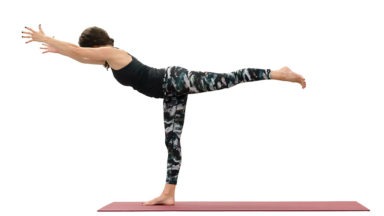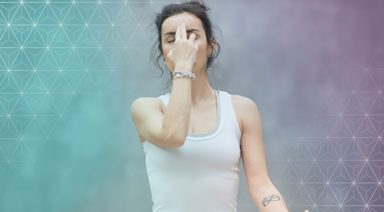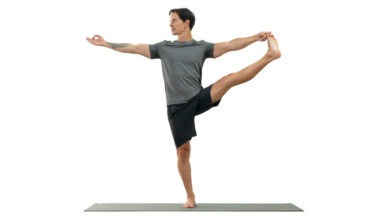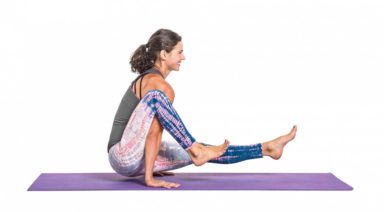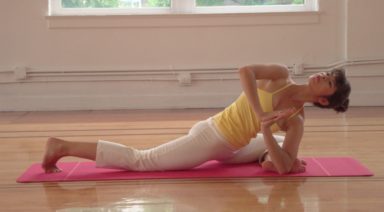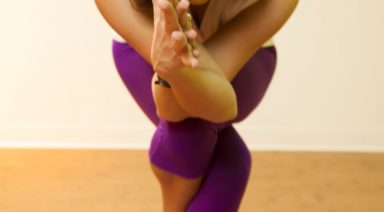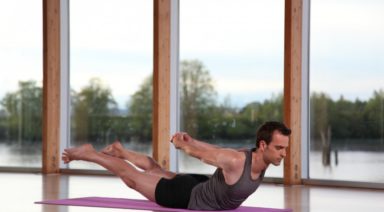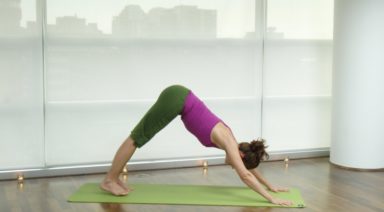Yoga Nidra

Yoga Nidra is Sanskrit for Yogic Sleep. A powerful technique from the Tantric Yoga tradition, Yoga Nidra creates an altered state of consciousness allowing the practitioner to enter the realm of subconscious and create effective and seemingly magical changes in their life. Yoga Nidra is a part of the Pratyahara limb of Raja Yoga, one of the eight limbs of yoga; the well known codification system of the Yogic practices by Patanjali. Pratyahara deals with the withdrawal of the senses and the influences of the mind which do not serve us on the path of enlightenment.
Yoga Nidra meditation is so inherently powerful that it has been kept secret for nearly 4000 years until the 1960’s when it reintroduced to western students by Parmahansa Stayananda Saraswati.
Most people are familiar with the power of affirmations but many also don’t realize that affirmations can be made infinitely more effective if one is to access the subconscious mind to plant the seed of a new belief. In fact most conscious affirmations methods are ineffective because they don’t manifest in the subconscious.
Under the guidance of an experienced teacher, you will relax your nervous system in the most powerful way available to humans without chemical agents. Once you reach this deepest state of physical and mental relaxation the mind becomes receptive to new concepts. In this manner as we access the subconscious through specifically designed sequences of visualizations you will have an opportunity to implant an affirmation of your choice, which will then manifest in your life.
Before you begin the Yoga Nidra practice formulate your affirmation.
An integral part of the Yoga Nidra practice is the silent repetition at 2 separate time intervals of a sankalpa, a resolve or affirmation. The correct formulation of the resolve is critical to the success of the practice. Because the subconscious mind speaks in it’s own language we must structure the wording of our intent to be accessible and clearly translated by the subconscious.
There are 7 main rules that need to be followed for the outcome to come to fruition:
- The resolve should be stated in a simple language and contained within one sentence.
- It should be made in the first person by using “ I am…” I have…” I create…” “ I feel…”
- It must be structured in positive language. No mention of the negative state should be made, instead the positive desired outcome state should be affirmed. For example, if you desire to attain recovery from a medical condition it should not be structured as “I am not sick” instead a positively stated desired outcome should be utilized such as “I have perfect health” Or “My physical body is in perfect health and balance” etc. No words such as: not, don’t, won’t, can’t, should be used. The statement should be joyous in it’s essence.
- Present tense. Because the subconscious mind is timeless and operating in the moment all affirmations should be stated as if they have already come into being. In this way unlike the petitionary aspect of prayer, we simple affirm that which is already here. Eliminate doubt.
- Affirmations must involve you only. Do not wish change for any specific person. Do not wish for a specific person to change their mind, their condition or their life path to suit your desires. If you are wishing for a partner to manifest in your life, you can describe them but not anyone you know or know of specifically. The practice must respect the free will of all beings.
- When repeating the sankalpa during the practice one should involve all faculties of the imagination and invoke strong emotions to the experience affirmed. Strong emotions create a powerful binding mechanism within our subconscious.
- Patience. Depending on the complexity of the request the manifestation may take linear time to come into full being. Practice yoga Nidra until the desired outcome is achieved.
All of this requires a leap of consciousness and faith to grasp. This is the magical aspect of the practice. Knowing how this works is irrelevant compared to the knowing that it does work.
9 Yoga Poses for Relieving Shoulder Tension

Yoga, when practiced regularly, relaxes muscle tension and in the process, also strengthens the relaxed muscles. Here are a list of poses that will help relieve tension around the shoulder area:

1. BALASANA (CHILD’S POSE)
Child’s pose is a very good way to start a practice. It’s also an excellent rest pose during a vigorous flow.
Come to your hands and knees, press your hips back into your heels. Open your knees out toward the corner of your mat and rest your belly and chest between your thighs; arms out in front of you and palms up. Allow your shoulders to melt downward. This is a gentle way to start warming up the shoulders.
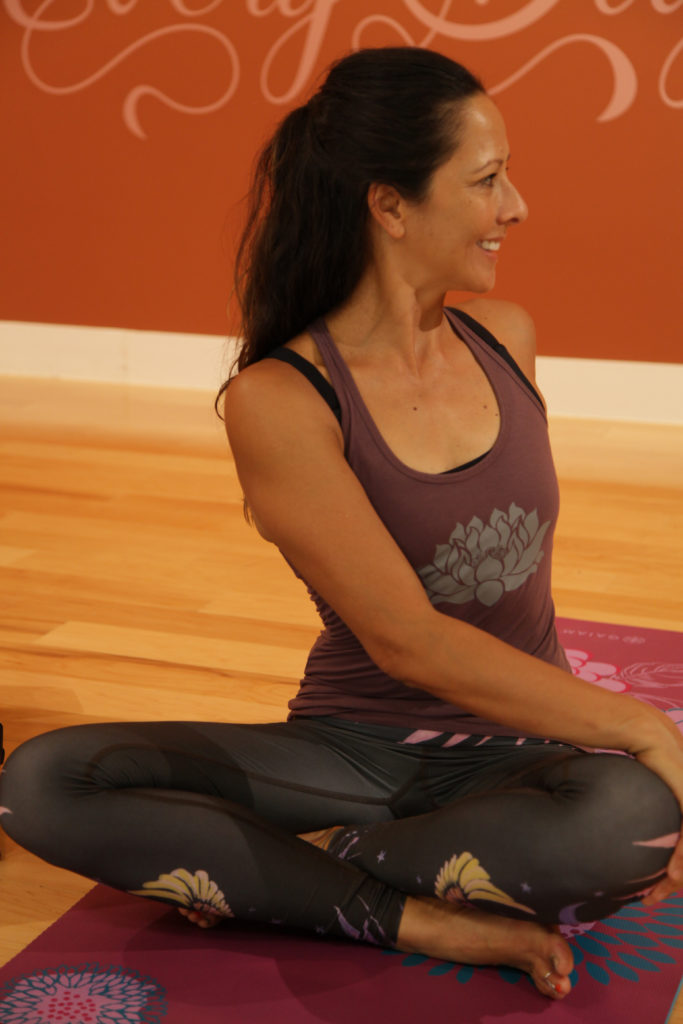
2. BHARADVAJASANA I (SEATED TWIST)
Sitting crossed legged, stretching your spine tall, place your left hand on your right knee and your right arm on the floor at your right hip. Draw a breath in and turn your shoulders and upper torso to the right.
The idea here is to stay gently grounded in the sits bones while extending the spine upward. If you’re twisting right, then ensure your left hip stays grounded. Lift as you inhale and turn as you exhale. Keep your gaze over your right shoulder. Try to keep your shoulders at the same height, and keep your neck soft. Your chin should be in neutral, but if you want an added stretch, you can tuck the chin. Hold for a few breaths, and then come back to center. Repeat on the left side.

3. SUPTA BADDHA KONASANA (RECLINING BOUND ANGLE POSE)
This pose offers a stretch across the chest and releases the shoulders.
Lying on your back, put a bolster or a block longways between your shoulder blades. Bring the soles of your feet together and allow your knees to fall open. If that is too intense, just leave the legs long and resting on the mat. Rest your arms by your sides. You will notice that if you turn your palms to face up, that will increase the rotation in the shoulders. You can either support your head or, if it feels good, allow your head to drop back (this will stimulate the thyroid).
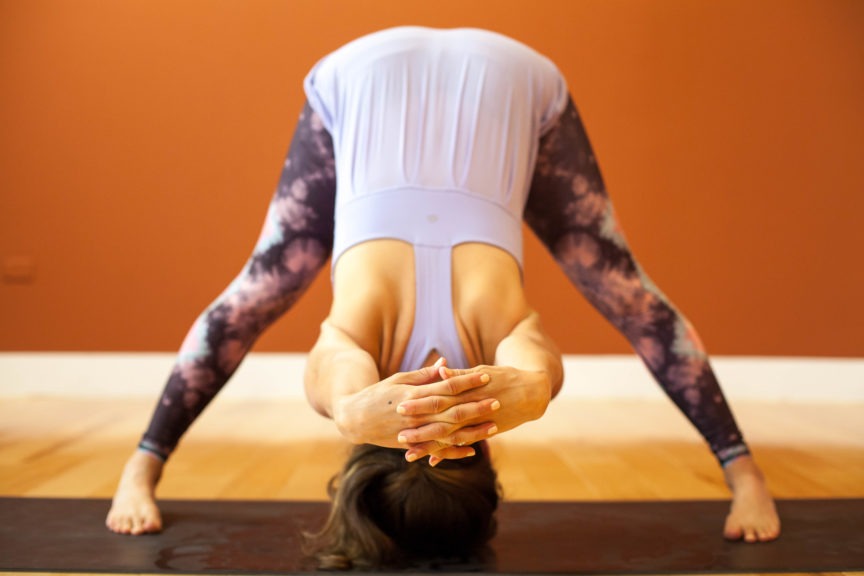
4. PRASARITA PADOTTANASANA (WIDE-LEGGED FORWARD FOLD)
Standing with your legs wide, turn your toes inward slightly and heels out. Bring your hands to meet behind your back and interlace your fingers. If that is not accessible to you, hold a towel or a strap between your hands. With an inhale, lift your chest and roll your shoulders back, extending the hands backward. On the exhale bend forward, keeping a slight bend in your knees. Allow gravity to draw your hands over your head. This creates a lovely rotation in the shoulders. Hold this pose for at least eight breaths (inhales and exhales).

5. SETU BANDHASANA (BRIDGE POSE)
Lie down on your back and bend your knees, feet hip width apart and on the mat. As you breathe out, press your feet into the mat and raise your buttocks, lifting the sternum towards the chin. Elongate the back of the neck onto the floor and breathe deeply. Reach for your feet with your hands, while rolling on to your shoulders. Keep your head still with your nose pointing up and gently press the back of your head into the mat, all the while lifting the hips.
You have the option of supporting yourself with your hands under your hips, or on a block. As you breathe, and your body starts to open, try to walk your shoulders closer to each other and reach your hands towards your feet. This will help open the chest. Move your chest toward your chin. This pose is also great for calming the mind.

6. PASCHIMOTTANASANA (SUPPORTED FORWARD BEND)
This pose is meant to release and relax your neck. Sit on the floor in front of a chair. Place a pillow on the chair, and rest your head on the pillow with your arms just under your forehead. Gently stretch the neck muscles by dropping the chin to the chest. Breathe in and out while resting your head on the pillow.

7. GOMUKHASANA (COW FACE POSE)
When we sit in front of a computer we round our shoulders and push our chins forward. This pose is great for helping to correct our posture.
Sit up straight in a comfortable cross-legged seat. Lift your left arm straight up, palm turned inward and thumb pointing to the back of the room. Bend that arm and reach it down between the shoulder blades. Now extend your right arm to the side, thumb down and palm facing back. Bend the arm and bring the elbow in to the side and reach up between the shoulder blades. Take hold of the other hand. If this is a little hard, use a strap between the hands. Lift your heart and press into your sits bones. Keep your chin in neutral and the neck soft.

8. SAVASANA (CORPSE POSE)
This pose is often used in meditation with the intention of complete relaxation.
Lie on your back, arms by your sides. Spread your feet apart and allow them to drop open. Let your arms rest by your sides, palms up. Allow your fingers to curl up naturally. Lift your shoulders, broaden them and then let them melt into the mat as you exhale. Breathe with deep, smooth breaths.
Support your body where you need to. Sometimes a bolster under the knees, or between the shoulder blades feels good.

9. YOGA OFF THE MAT
In a seated position, come to the top of your sits bones and gently draw your belly in. Lift your heart and allow your shoulders to slide down your back. Keep your chin in neutral and allow for a good distance between the ears and shoulders. This is also a good posture to hold when you are standing or walking. Keep the tailbone gently tucked under.
Remember to keep moving your body. It is joyful, gives us energy and keeps us healthy.


